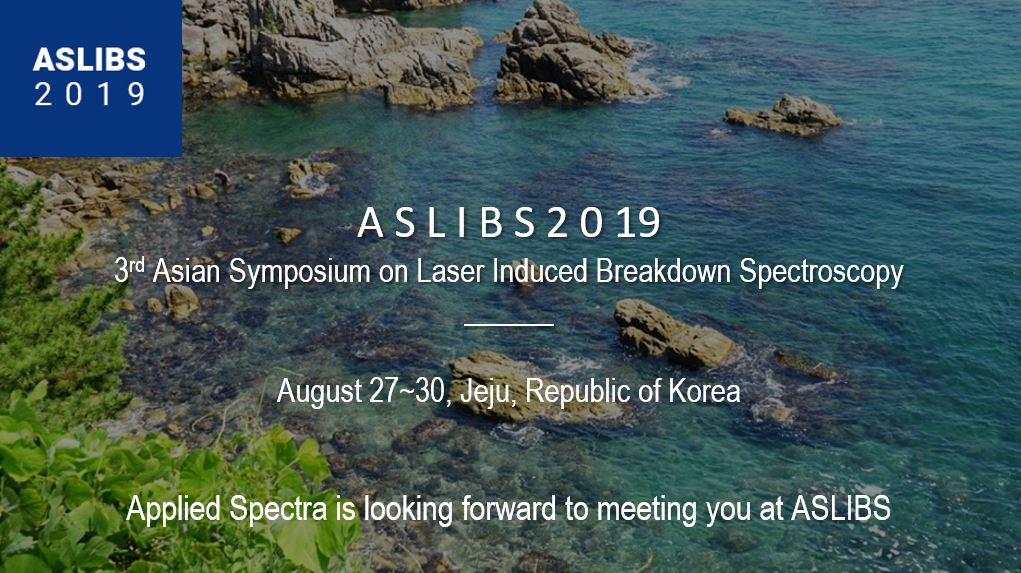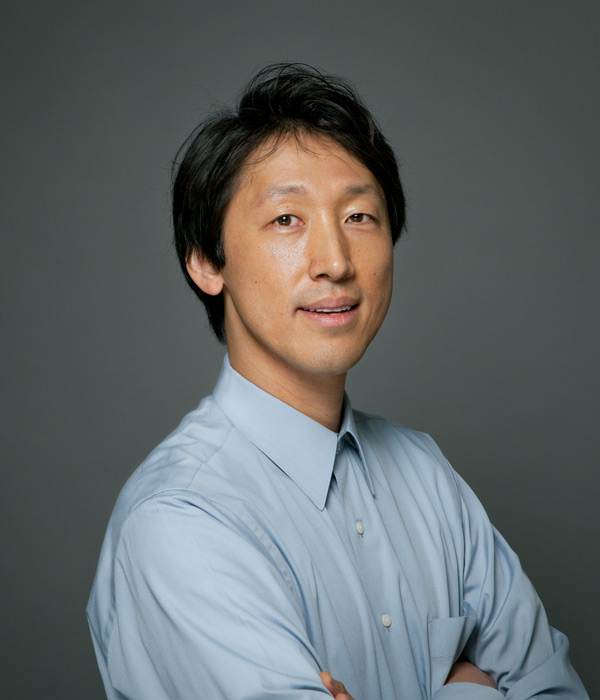Meet Applied Spectra at ASLIBS 2019, Jeju, South Korea
Ready to showcase the most advanced LIBS Technology at the 3rd Asian Symposium on LIBS (Jeju, South Korea from August 27~ 30)

LIBS (Laser Induced Breakdown Spectroscopy) is rapidly becoming a main stream analysis technique. The use of LIBS is expanding in a wide range of commercial industries that include:
- Glass manufacturing
- Non-conventional (shale) oil production
- Li-ion battery manufacturing and FA
- Steel and by-product analysis
- Mining ore screening
- Polymer QC
- Thin film structure analysis
Applied Spectra is showcasing the latest technological advances for our J200 LIBS instruments.
Applied Spectra Korea team would love to connect with you to discuss a wide range of products to help advance your LIBS research and enable industrial applications. At ASLIBS 2019, we are highlighting
- Aurora LIBS spectrometer – customizable multi-channel spectrometer with the widest spectral range and high cost efficiency
- LIBS2 Technology – dual detector technology to get the best of the both CCD and ICCD detection
- Clarity LIBS Plus – advanced elemental imaging with LIBS
- QC and technician mode operation software
- J200 Tandem LA – LIBS technology – expand analytical capabilities with simultaneous LIBS and LA-ICP-MS
We look forward to meeting you at our booth in the main exhibition hall.
Applied Spectra is a proud PLATINUM sponsor of ASLIBS 2019.
Featured Presentation from Applied Spectra at ASLIBS 2019
Invited Oral Presentation

Session 8: LIBS for Energy & Nuclear Applications
Title: Advancing LIBS for Next Generation Energy Source and Storage Applications
Speaker: Jong H. Yoo, Ph.D, CEO & President, Applied Spectra, Inc
Date and Time: Wednesday 28th, August, 16:30-16:55
Location: 8F, Tamna Hall
About the talk:
Securing abundant and accessible energy source for power generation and technology for efficient energy/power storage have been of strategic importance for many developed nations. Energy generation and storage is critical in maintaining nation’s economic stability. While the world most popular energy source, petroleum, has been extracted from land or offshore drilling in the past, more and more non-conventional resources are becoming a significant part of the overall global petroleum production. The shale, in particular, has seen a tremendous rise as an alternate source for petroleum and natural gas. Due to ability to measure both inorganic and organic chemical constituent in the shale rock, LIBS (Laser Induced Breakdown Spectroscopy) is an analytical technology that is starting to play a vital role in understanding of petroleum maturity, hydrocarbon structure, content, and distribution, and chemical processes that impacts long term production of petroleum and natural gas from shale samples.
In addition to unconventional petroleum energy resources, the solar energy is another energy source that can reduce the nation’s reliance on the petroleum and eliminate detrimental environmental effects associated with the fossil fuels. In order to fully utilize energy generated from the sun, the storage technology such as Li-ion battery must advance to enable higher storage capacity and output and to access the stored power at non-peak hours when needed. LIBS also provides the analytical capabilities to advance the Li-ion battery manufacturing in controlling the target chemistry of various fabricated components. With LIBS, it is possible to track the change of binder distribution and conductive agent in the electrodes and correlate these changes to the performance of the Li-ion battery performance metrics. In this presentation, the examples of growing LIBS application and potential for rapid QC in shale oil and gas exploration and Li-ion battery manufacturing will be highlighted.
Poster Presentation
Title: A Study of analysis techniques of SiC fiber by various sampling methods with LA-ICP-MS
Date and Time : Tuesday 27th, August, 15:05 ~ 16:30
Author: Byuengseo Son, Donghyun Ki, Myungkyu Lee, Hyunsik Kim, Jhanis Gonzalez, Jong Yoo, Young Hwa Hong, Chang Rae Cho (Applied Spectra Korea & Korea Institute of Ceramic Engineering and Technology)
Abstract: As the fourth industrial revolution involves industrial technology development, considerable progress has been achieved in the field of material science. Aviation, aerospace and renewable energy industrial sectors require a new generation of advanced materials that can withstand in harsh environments. In particular, silicon carbide (SiC) fibers are widely used as a composite that reinforces materials since they have properties such as high strength, flexibility, chemical and heat resistance that are required in extreme conditions. However, SiC fibers do not dissolve in acids thus it is difficult to analyze trace metals by typical solution-based elemental analysis techniques. For this reason, analysis using Laser Ablation Inductively Coupled Plasma Mass Spectrometry (LA-ICP-MS) is one of the best techniques to determine trace elements in SiC fibers.
The purpose of this study is to analyze SiC fibers under various sampling conditions and find a suitable sample preparation method for LA-ICP-MS analysis. In this study, sample preparation of SiC is conducted in various ways. A single fiber and a filament are attached to double-sided adhesive tape and carbon tape respectively. Also, fibers are mounted in epoxy with filaments in both horizontal and vertical directions.
Title: High Resolution LIBS imaging of CIGS solar cell using Clarity Plus
Date and Time: Tuesday 27th, August, 15:05 ~ 16:30
Author: YoungHwa Hong, ChangRae Cho, Jhanis Gon zalez, Chuck Sisson, Alan Koenig, Juan Carlos Guerrero and Jong Yoo
Abstract: Among many of the advantages of performing chemical analysis by Laser Induced Breakdown Spectroscopy (LIBS), such as direct analysis of solids, rapid assessment and flexibility in different environmental and pressure conditions, etc. the clear stand-out is the capability to provide information on elemental spatial distribution. This information is presented in the form of 2D or 3D images after extracting the intensity of the detected species (i.e., atoms, ions or molecules) from each LIBS spectrum or by plotting the calculated concentration of the species of interest when standard reference materials are available. LIBS is an all-optical technique that can produce space-resolved images containing elemental information with ppm limits of detection and micrometer resolution. Another significant asset of this technique lies in its acquisition speed. The speed of producing chemical images using LIBS is only limited by the laser repetition rate (up to kHz) and the detector speed. The imaging capability of LIBS will be demonstrated together with a presentation of the powerful software for data and imaging processing called Clarity Plus by Applied Spectra, Inc. Many fields are benefiting from this capability. In this paper, advanced LIBS imaging technology demonstrates its ability through an analysis of copper indium (gallium) diselenide (CI(G)S) solar cell. The software enables to identify the elemental compositions of the CI(G)S solar cell as well as the distribution of constituting elements in layers of a few micrometers thick using high-resolution images.
Notable Presentations from Our Research Collaborators
Oral Presentation (Tamna Hall, 8th Fl)
Title: Calibration strategies for quantitative analysis in low alloy steel by LIBS
Session: 3 -LIBS for Industrial Applications (1)
Date and Time: Tuesday 27th, August, 14:20 ~ 14:35
Speaker: Sehoon Jung (RIST)
Title: Application of laser-induced breakdown spectroscopy for recycling of scrap metals
Session: 4 -LIBS for Industrial Applications (2)
Date and Time: Tuesday 27th, August, 17:10 ~ 17:25
Speaker: Sungho Shin, YoungminMoon, Jaepil Lee,Seongmin Hong,
Eunsung Kwon, MinjaeCho, Euiseok Hwang,Kyihwan Park, Sungho Jeong (GIST)
Title: Quantitative analysis of Mg, Ca, K, and S in edible salt products using laser-induced breakdown spectroscopy
Session: 5 -LIBS for Ocean & Geological Applications
Date and Time: Wednesday 28th, August, 9:00 – 9:25
Speaker: Yonghoon Lee (Mokpo National University)
Title: Study on the failure characteristics of heat-resistant steel by laser-induced breakdown spectroscopy
Session: 7 -Chemometrics & Biomedical (1) Applications
Date and Time: Wednesday 28th, August, 14:00 – 14:15
Speaker: Meirong Dong, Shengzi Lu, Jianwei Huang, Jidong Lu (South China University of Technology)
Title: Real-time monitoring of heavy metal components of fine dust air pollution using laserinduced breakdown spectroscopy and spark-induced breakdown spectroscopy
Session: 10 -LIBS for Industrial Applications (4)
Date and Time: Thursday 29th, August, 10:40 – 10:55
Speaker: Junho Yang, Jae-Hun Jung, Jack. J. Yoh (Seoul National University)

